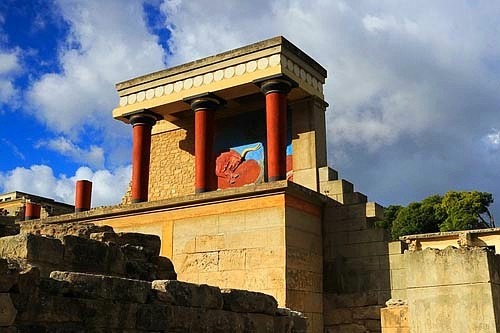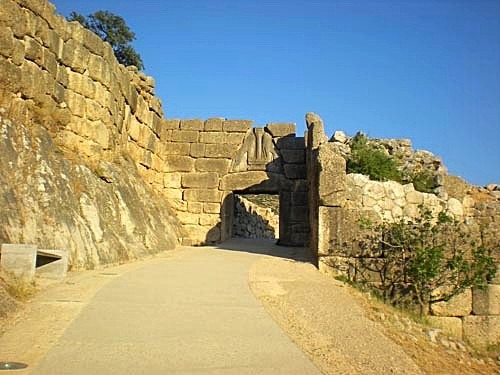Monuments of lost civilizations
Plenty were the ancient civilizations that left their mark on the planet indefinitely, but over the centuries, they either began to slowly decline or were lost to natural disasters. Monuments of these cultures still exist today and they are just as impressive as they were when they flourished.
Minoan civilization - Knossos Greece
The prehistoric culture of Crete, named after the Minoan by the archaeologist Arthur Evans, in honor of the mythical King Minos, flourished during the Bronze Age (3000 BC - 1000 BC). Important events of the period were the construction of the Knossos palaces, the eruption of the Santorini volcano and the destruction of Knossos. The cause of the destruction of the Minoan civilization remains a mystery even today. Knossos was the capital of Minoan civilization and the palace of King Minos. The Knossos Palace Archaeological Site is located south of the city of Heraklion, Crete Greece.
Mycenaen Civilization - Mycenae Greece
Mycenaean civilization flourished in the late Bronze Age (1600 BC - 1100 BC), mainly in southern and central mainland of Greece. Archaeological findings show that it had spread throughout the eastern Mediterranean, Crete, the Aegean islands and Cyprus. Some theories even allege that the Mycenaeans arrived on the island of Crete and plundered the already wounded Minoans. The Acropolis of Mycenae is located about 90km southwest of Athens, in the prefecture of Argolis. The discovery of the Mycenaean archaeological site was made by Henry Schliemann.
Inca Civilization - Machu Picchu Peru
Incas was an empire that dominated during the pre-Columbian era. They flourished from 1430 AD to the mid of 16th century when they were conquered by the Spanish "conquistadores". The Inca Empire, with Cusco of Peru as its capital, counted more than 200 nations from Ecuador till Chile. The Lost City of Inca, Machu Picchu, which in Quechua means "Ancient Mountain", was discovered by archaeologist Chiram Bingham in 1911. It is about 80 kilometers from Cusco, perched at an altitude of 2700 meters.
Mayan Civilazation - Chichen Itza Mexico
The Mayans were Central America people and their culture occupied an area from Mexico to Guatemala and Belize. Evidenced by archaeological findings, Mayan civilization begins before 2000 BC. It is the most brilliant civilization of the Western Hemisphere and one of the most important in world history. The reasons for their disappearance remain unknown. Chichen Itza, the capital of the Mayan empire, which in their language means "at the mouth of the Itza well," is located on the Yucatan Peninsula in Mexico.
Ancient Egyptian Civilization - Monuments of Giza Egypt
One of the oldest and most advanced civilizations in human history is that of Ancient Egyptians. It developed mainly along the Nile River and flourished for about 3000 years. In the Giza area, around 20km far from Memphis, the capital of ancient Egypt, are some of the most impressive monuments in the world, such as the Necropolis, the Great Sphinx, and the Pyramids of Giza.
Culture of Hittites- Hattusa Turkey
Hittites civilization was of paramount importance, flourished around the 2nd millennium BC in Asia Minor and Near East. The Hittite Empire collapsed suddenly around 1200 BC, for unknown reason till today. Discovered by accident, William Wright brought to light this hitherto unknown culture and in 1906 the German archaeologist Hugo Winkler began excavations at Hattusa. Hattusa was the empire's center till Hittites fall. The archaeological site lies about 200km east of Ancara, close to Boğazkale village in Turkey.
Indus Valley Civilization - Mohenjo-daro Pakistan
Around 5,000 years ago, in the Northwest Indian and Pakistani regions, there was a really large and important civilization. It was mainly developed along the Indus River, so called the Indus Valley Civilization. It is of great interest that this culture flourished for almost 700 years in total peace, fostering a society without class differences. It appeared around 2600 BC and disappeared all of a sudden around 1900 BC. The largest ancient city in the Indus Valley culture is Mojenzo Daro, discovered in 1920 by John Marshall in the Sindh Province of Pakistan.
Achaemenid Civilization - Persepolis Iran
The Achaemenid dynasty was the First Persian Empire, dating back to 650 BC. People were excellentcraftsmen and experienced warriors.The Persian society was divided into three classes, the warriors or nobles, the priests and the peasants. Due to the vast expanse of the empire, which stretched from Iran to Egypt and Thrace, the Achaemenid civilization was influenced by the social and cultural traditions of their conquered nations. The end of the Achaemenids came after the overthrow of Alexander the Great, who actually overthrew the Persian Empire. Persepolis was the capital of the Achaemenid Empire built by Darius in 520 BC. The archaeological site of Persepolis is about 60km northeast of the city of Shiraz in Iran.








